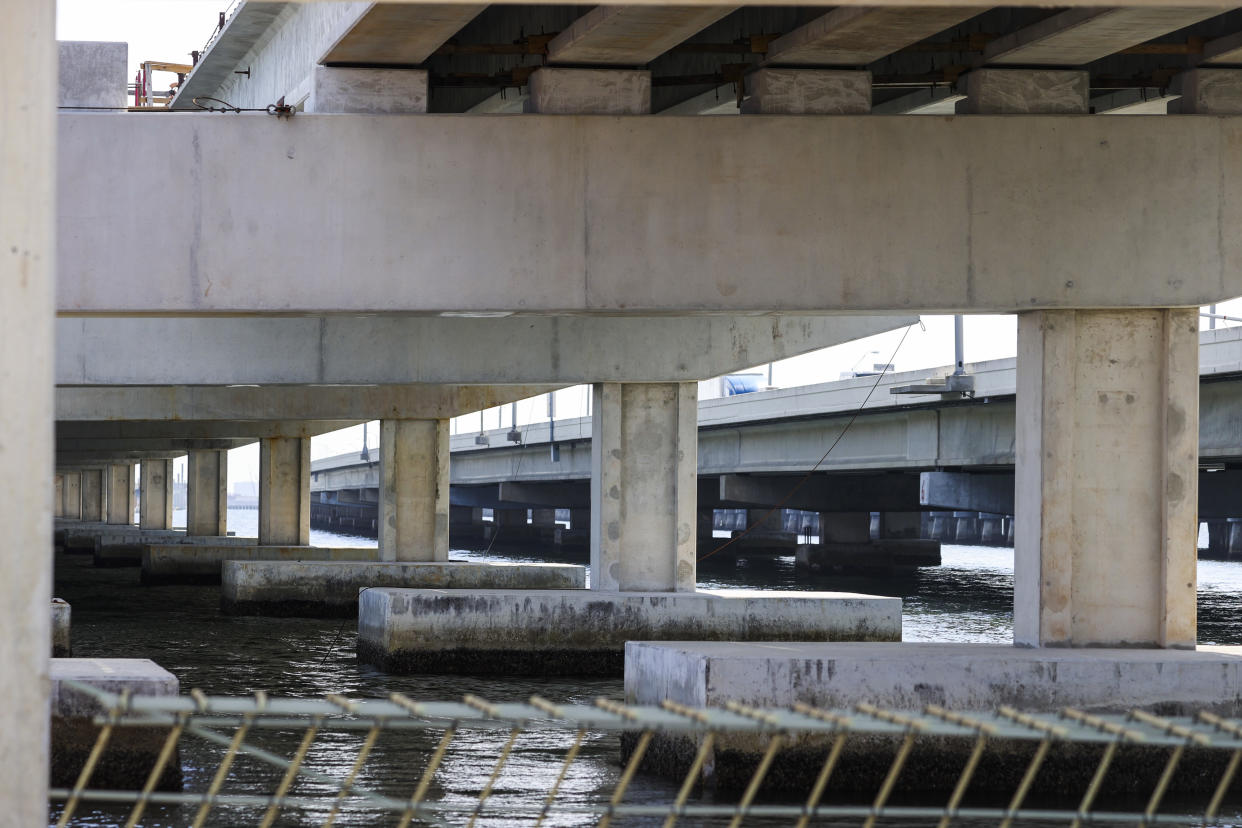Drivers will see major progress on the Howard Frankland in 2024

Drivers can expect the new Howard Frankland to look more like a nearly completed bridge in 2024.
One of the Florida Department of Transportation’s largest construction ventures in a generation is meeting all goals for the end of the year, project officials said. The last of the bridge’s concrete piles — the basis for its foundation — will be driven into the floor of Tampa Bay by the end of December.
Next year, commuters will begin to see what those in the construction industry call the bridge’s “superstructure.” In layman’s terms, the skyline of towering cranes and concrete will be joined by a deck, which will eventually become road.
The next phase of the project will show more visible signs of progress, said Greg Deese, a construction engineer for the Florida Department of Transportation’s District 7, which covers Citrus, Hernando, Hillsborough, Pasco and Pinellas counties.
“Anything that’s primarily vertical, sticking out of the ground — we’re nearing the completion of a lot of those elements,” Deese said. “What drivers are really going to start to see are beams — the horizontal elements that go between the columns. That’s what really starts making it look like a bridge.”
The Howard Frankland is now composed of two spans: One has four southbound lanes, the other four northbound lanes. None are tolled. The new construction will become the southbound bridge, with four general-use lanes, four express toll lanes (two in each direction), and a 12-foot-wide bike and pedestrian trail. The toll price will change based on the amount of traffic in the lanes. Previous reports projected between 15 cents and $2 per mile.
The old southbound bridge will switch directions, to become the northbound bridge.
Work on the new span began in 2020. About 250 crew members work on-site at all hours of the day and night, with additional crew elsewhere in support roles. The project is set to be completed by the end of 2025.
“We’ve been sticking to that, and it looks like we’re going to be able to make that date,” said David Alonso, construction project manager for the bridge.
This year got off to a slow start, Alonso said, when contractors found a layer of very hard limestone material, called “chert,” on the floor of the bay. The discovery prompted a search for stronger — and more expensive — equipment to break through the material. This was necessary to properly drill the concrete piles — which pin the bridge to the seafloor — into the ground.
Acquiring new equipment did not increase the project’s $865.3 million budget, a Department of Transportation spokesperson said.
After the hiccup, “things picked up pretty quickly and the contractor has been making up for that time,” Alonso said. “The way we view it, we’ve overcome the greatest obstacle.”
To date, nearly all of the bridge’s 3,000 or so concrete piles are in place. Atop the piles are the footings: thick, concrete slabs that help evenly distribute the weight of everything above. About 88% of footings are complete.
Over the footings, 87% of columns have been placed. And connecting the columns, the crew has installed 78% of pier caps, another wide row of concrete that distributes the load.
All of this is part of the bridge’s support structure. More than 900 beams are in place on the existing caps, as well.
By the end of December, the rest of the concrete piles will be driven, and by spring of next year, what’s remaining of the bridge’s foundation will be complete. That includes around 40 more footings, 60 columns and 43 caps. All of the bridge’s beams will be installed by the end of 2024, making way for the deck.
As early as the end of next year, drivers may see changes to their daily travel, Alonso said, as they begin filtering onto the new bridge, and as the existing southbound bridge switches direction.
The existing northbound span — slated to be demolished after the new southbound project is complete — was built in the late 1950s. And it was due for an update, Deese said. But commuters also know the entire bridge to be a frustrating bottleneck for the region, prone to congestion and hourslong stationary traffic. It has a reputation for severe, and sometimes deadly, pileups.
That congestion is only expected to increase with population growth, as 100,000 people are projected to move to Tampa Bay in the next 25 years. Already, just under 193,000 trips are made across the 4-mile stretch every day, easily the region’s most traveled route.
The addition of express lanes — part of the transportation department’s Tampa Bay Next initiative to modernize the region’s infrastructure — aims to expand the route’s traffic capacity. The same can be said of the bike path and the added space for light rail, should the region opt to install it in the future, Deese said.
“It does offer us a lot of flexibility,” he said.
The new span will be 98 feet wider and the state’s largest bridge by deck area.

